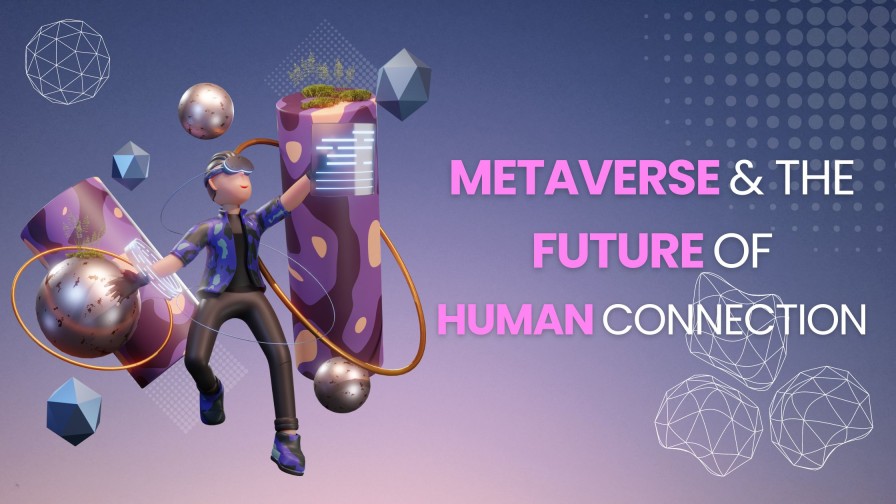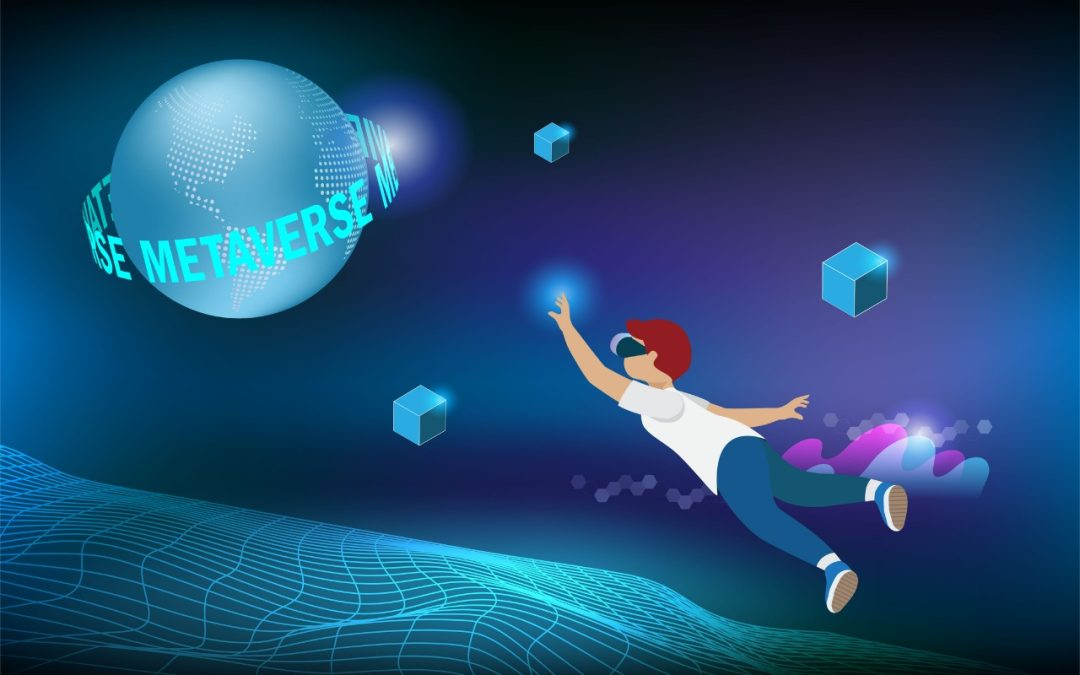Metaverse- A Future Reality Or Just A Hyped Sensation!
It seems that the Metaverse is still in its early stages; it is only a question of time as if people are looking at the caterpillar; the butterfly will come later.

Which is the most recent hot technology that vanished as swiftly as it appeared? Metaverse is the answer- which is nothing but a virtual realm! Yes, you read that right. The groundbreaking notion that promises to revolutionize human digital experiences generated much buzz profoundly. However, nearly two years after Mark Zuckerberg rebranded Facebook as Meta, establishing the social media behemoth as the forerunner of the physical world’s parallel reality, the notion of revolution has faded.
In the face of rising interest rates and inflation, numerous firms have placed their metaverse ambitions on hold, while others have diverted resources to other technologies like AI, where implementation appears to be easier and the RoI is visible. Furthermore, problems like high device prices and the interaction of many technologies keep this virtual realm a faraway reality. Down the lane, we go deep into the Metaverse’s vision, the enthusiasm it generated, and the future of revolutionary technology.
A bright future- The promise made which garnered all the limelight.
The virtual realm involves individuals engaging in a 3D virtual web world via avatars. They will travel, attend meetings and conferences, do banking, shop, study, acquire real estate, and incorporate much more of their actual lives into the Metaverse.
According to global giants such as Goldman Sachs and PwC, the metaverse industry will be valued at almost USD1 trillion in less than a decade as people migrate from 2D online experiences to richer, immersive, real-like interactive experiences in the 3D Metaverse.
The industry is heavily invested in identifying and developing viable solutions to bring it to reality. This virtual realm is roughly where the Internet was in 1993 or so, showing some promise, sarcastically. But the true breakthrough and earth-shattering things are still to come after humans tackle the core infrastructure issues, says Leslie Shannon, Nokia’s head of ecosystem and trend scouting, underlining the hopeful vision of new-age technology.

The owner of Facebook, WhatsApp, and Instagram, Meta, was among the most bullish, spending billions on the Metaverse. The notion of avatars interacting in virtual spaces was ideal for improving digital lives. Therefore, businesses began booking virtual real estate across metaverses. JP Morgan set up shop in Decentraland, one of the most popular metaverse locations. Nike sold shoes, while Gucci, Louis Vuitton, Coca-Cola, Tanishq, and others established themselves in the Metaverse. Nike alone has spent about USD200 million on this virtual realm’s efforts.
While the virtual realm was heralded as ushering in a digital era of phantasmagoria, the magic lantern that projected dreams as real or imagined beings remained elusive. Why? The answer is deep down the line.
AI comes into play- The first parameter which played the role of an obstacle for the world of Metaverse.
When AI took the world by storm, most of the creation of the Metaverse had only just begun. To make matters more complicated, the Metaverse is not a single technology but the convergence of several, including spatial computing, 3D environments, and augmented reality (AR) and virtual reality (VR) headsets, each with its own set of challenges, ranging from high costs to a lack of practical use cases.
With AI promising a faster impact on productivity and performance, the metaverse concept vent on ‘ventilator’.
- Disney and Microsoft have placed their virtual realm ideas on hold in order to focus on AI.
- Microsoft halted work at its industrial metaverse business and shrunk its AR and mixed reality (MR) teams in February of this year.
- Reality Labs, Meta’s subsidiary, has wasted more than USD20 billion on this virtual realm initiative.
Companies require a clear return on investment. If they can’t see it, it’s just an experiment that will disappear. As a result, the focus has switched to AI, fueled by OpenAI’s bot ChatGPT’s generative capabilities, which aid in creating material, text, videos, and graphics. Hence the scorecard is like AI=1 and Metaverse=0.
According to Gaurav Vasu, CEO of UnearthInsight, a Bengaluru-based research business, over 90% of Indian enterprise metaverse funding has been shifted to generative AI, mostly because tech services providers see income and practical client implementation potential here. He claims that retail and automotive corporations have decreased their metaverse budgets by 100% and put them back by at least 12-18 months.
UnearthInsight forecasted a USD500 million-USD600 million investment in the Metaverse from more than 100 Indian firms in 2021-22. This is now transitioning to.
But the main question is whether AI encroaches on the Metaverse’s territory?
While several preceding trends and research discoveries hint in that direction, Shannon has a different viewpoint. She claims that the metaverse/XR/spatial computing worlds are big and increasing, citing patterns from the Augmented World Expo, an annual gathering of people in the extended reality (XR) business.

The expo drew over 300 exhibitors this year, up from roughly 225 in 2022, and there are plans to move the event to a larger facility next year to accommodate the expanding number of participants. Shannon emphasizes that considering XR and AI as competitors is a common misconception.
‘Reality’ is in the works.
The Metaverse became popular at the beginning of this decade. To put things into perspective, consider how the traditional Internet and its associated ecosystem (computers, mobile devices, and other related services) grew.
In 1977, three computers were released: the Apple-II, the Personal Electronic Transactor (PET) by Commodore Business Computers, and the TRS-80 by Tandy Radio Shack. However, it wasn’t until 2007 that the iPhone was released, and mobile Internet became a commodity. However, it wasn’t until 2007, when the iPhone was released, and mobile Internet became commoditized, that Internet services evolved and became widespread.
In other words, the Internet (including the device ecosystem and services/applications) took about three decades to mature into its current form. Even businesses and apps that emerged in the 1990s, such as Amazon or Google Search, became ubiquitous only when the Internet was commoditized in the late 2000s.
However, this does not imply that the Metaverse will take 30 years to evolve and become widespread. Obviously, it will be faster, but it is critical to recognize that we are still in the infrastructure-building phase, which will take some time. We’re still in the first decade.
Though AI has created a lot of interest and new investments, the Metaverse is not dead. The ambition of building a 3D virtual collaboration space remains intact. The hype was far greater than what the products and services could deliver at the time.
While people value immersive experiences, they must be economical to be widely adopted. Considering the AR/VR gadgets required to reach the Metaverse, even though Apple is a premium brand, even those with a high spending proclivity may think twice about paying USD3,499 (roughly INR3 lakh) for an Apple Pro Vision, an MR headset released on June 4. Even after the price decreases, the Meta VR headsets Quest Pro and Quest 2 cost between INR30,000 and INR70,000. And that is costly!

While headset-free 3D monitors are still in the works and will not be commercially accessible for another two years, sales of VR headsets declined 12% in 2022 to 9.6 million units from the previous year. Headsets are also in their early stages. This problem will be solved with time, hard work, and investments by device manufacturers.
Can we create a bridge to fulfil the gap-the answer can be B2B.
According to an EY and Nokia study report published in June 2023, the Metaverse is futuristic. Though the Metaverse appears to be an immersive virtual world centred on gaming, social networking, and business at first glance, this is only a minor portion of the bigger subject.
The Metaverse is divided into three basic groups in the report: consumer metaverse, corporate Metaverse, and industrial Metaverse. According to the analysis, corporate and industrial metaverses will advance faster and give more real value than consumer metaverses, which are now receiving the most attention. The desire for improved digital communication and virtual collaboration is driving the Metaverse. In contrast, the industrial Metaverse is the integration of physical and computer worlds and human enhancement.
Though corporate and industrial virtual worlds are predicted to expand quicker than consumer metaverse applications, industrial applications are expected to outperform forecasts.
Supporting technologies must also grow for the larger metaverse ecosystem to evolve. Examples are non-fungible tokens (NFTs), cryptocurrency transactions, spatial computing, avatars, and digital people. However, as a result, because the ecosystem is costly, getting customers hooked on the Metaverse will be difficult.
Given the high expenses and issues with user experience in the consumer arena, B2B may be a suitable area to begin the Metaverse. Digital twins are a fundamental industry 4.0 application that will gain greatly from the rise of the virtual realm. Indeed, as the latter evolves, enterprises can engage with digital twins in an immersive environment. This makes predictive maintenance, issue detection, and repair more actionable, minimizing downtime and increasing productivity.
In various ways, the B2B metaverse may avoid the faults of B2C, including aims, services supplied, income methods, and data-privacy issues. It assists corporate clients in saving time and money by providing virtual tours (of, say, factories), virtual product demos, collaboration, transactions, and other services.

Whereas the B2C ecosystem focuses on providing immersive and entertaining experiences for users as an upgrade to the current 2D web, the B2B ecosystem is designed to provide functional and efficient solutions for businesses, with the appeal of lower costs and faster implementation. Training, education, improved remote work solutions, and other specialist services are among the options. In the long term, B2B metaverse use cases will help smooth out the kinks and make B2C adoption simpler.
Is it that easy, or it may sound like a lethal combination?
Though AI has seized the spotlight, the virtual realm may leverage the technology to boost its development and offers. Digital material enables interactions in the Metaverse. While replicating a real bank or a vacation resort in 3D, an enormous breadth and depth of material is required for immersive experiences. Generative AI can meet this demand by creating novel content, including text, images, and videos, to supplement existing digital content.
In terms of AI and metaverse integration and application, Nokia’s Shannon says, accessing Generative AI through an XR headset may be the most thrilling and transformative use case humans see for both technologies. Working together, these two technologies will realize their full potential.
It is seen as a productivity-enhancing tool for banks, content/media, edtech, financial services, and other industries. In contrast, the Metaverse is a broader ecological game. Companies are seeking ways to boost their margins in the short term. As a result, the Metaverse will take a back seat for at least the next 12 months. Aside from technical obstacles, the Metaverse must handle various non-tech issues, such as virtual harassment, the influence of long hours spent in the virtual world on mental health, and so on.
The final version.
For the time being, the good news is that the buzz is past, but the vision remains intact. The virtual realm will eventually become a reality, beginning with B2B places. In his keynote talk at the May 2023 event, Ori Inbar, creator of Augmented World Expo, emphasized the integration of AI with the Metaverse, saying, “XR is the interface for AI.” The interactions with AI will shift away from text and instructions and towards spatial context.

Some remain concerned about the survival of this virtual realm, fearing that the vision it presented may have lost its glitter. But, as the ecosystem evolves, reality will emerge in its digital incarnation.
It seems that the Metaverse is still in its early stages; it is only a question of time as if people are looking at the caterpillar; the butterfly will come later.




